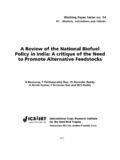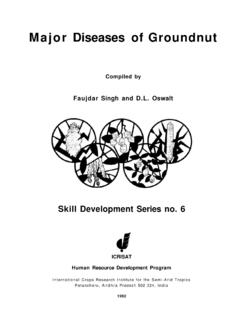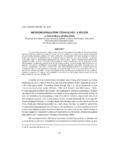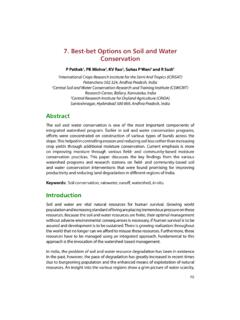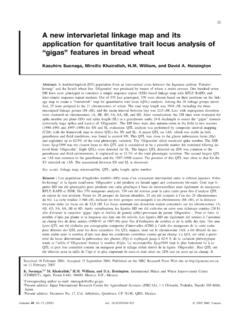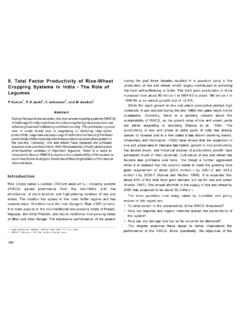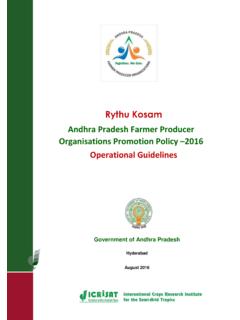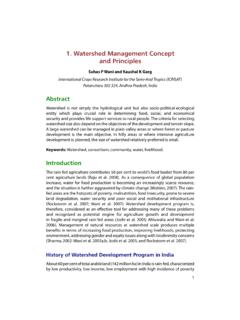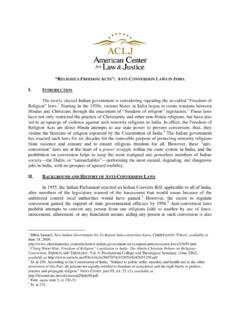Transcription of Agricultural productivity growth in Orissa, India: Crop ...
1 Vol. 8(19), pp. 2272-2284, 23 May, 2013 DOI: ISSN 1991-637X 2013 Academic Journals African Journal of Agricultural Research Full Length Research Paper Agricultural productivity growth in orissa , India: Crop diversification to pulses, oilseeds and other high value crops A. Amarender Reddy International Crops Research Institute for Semi-arid Tropics (ICRISAT), Patancheru, Hyderabad, India. Accepted 24 April, 2013 The extent of India's regional disparities has been an issue since many decades, and this concern has been partly motivated by a desire to alleviate poverty. Agriculture remains an important feature of the economic, cultural and political landscape in India. orissa is one of the poorest States in India. Over the last four decades, there has been stagnation in agriculture in orissa .
2 During the period 1991 to 2008 the growth rate of agriculture in orissa is lower than all India. orissa agriculture is highly concentrated in low productive and high water consuming paddy cultivation with little diversification towards pulses, oilseeds and other high value crops (HVCs): included sugarcane, fruits and vegetables etc., which fetch higher net returns. It is also characterized by low use of fertilizer, energy and irrigation per unit area compared to other states. There is a need for increase in area under certified seed, irrigation and other productivity enhancing inputs to increase farmers' income in all crops. There are perceptible regional disparities with the Coastal Plain having a distinct advantage in Agricultural production compared to the Central Table Land region, Northern Plateau and Eastern Ghats regions as better initial socio-economic conditions in the Coastal plains in 1971 are having positive influence in growth in later years.
3 Significant income gains are possible through crop diversification from paddy to pulses, oilseeds and HVCs in upland rain fed areas in kharif (rainy) season, if proper drainage, institutional and policy support is provided in Eastern Ghats and Northern Plateau of orissa . Key words: Sugarcane, oilseeds, productivity , diversification. INTRODUCTION The extent of India's regional disparities has been an issue since at least independence, and this concern has been partly motivated by a desire to alleviate poverty (Datt and Ravallion, 1996). Agriculture remains an important feature of the economic, cultural and political landscape in India. Datt and Ravallion (1996) demonstrated that the poverty responds more to rural and Agricultural economic growth than urban economic growth in developing countries.
4 In the post-green revolution period, particularly in Asia, productivity growth has been sustained through increased input use and, more recently, through more efficient use of inputs (Pingali and Heisey, 1999). India is divided into 28 states on administrative reasons. Regional perspectives of the development discourse were seen in the writings of Myrdal (1957) suggesting cumulative causation and core periphery models, which were elaborated upon by many other studies. They were of the view that regional imbalances were likely to widen in the absence of state intervention and narrow with politically necessary interventions, till finally the periphery becomes a beneficiary of the external economies of the core *Corresponding author.
5 E-mail: (Williamson, 1965). However, after 50 years of planned development in India, many backward regions remain backward. Recently both inequalities among states and inequalities among districts or regions within states are growing across many states due to misguided policy (Audirac, 1997; Kurian, 2000). orissa is one of the poorest states located in eastern India where about 85% of the population lives in rural areas (Map 1). Agriculture is the mainstay of the State s economy, providing employment to about 65% of the total work force, but it contributed only to the net state domestic production in 2009 to 2010. More than 46% of the population lives below the poverty line in rural areas, as against 37% for all India in 2004 to 2005.
6 Percentage of small farmers (with less than 2 ha of land) is about 57% and landless laborers are about 36% of total households in rural orissa (Mishra, 2009). In most of the development indicators, orissa is backward compared to other states ( orissa Development Report, 2004) with large populations of scheduled tribes (22%) and scheduled castes (17%) who are socio-economically backward compared to other population. orissa is million hectare (mha) in geographical area, of which about mha is cultivated land with a cropping intensity of 160%, indicating 60% of the net sown area is cultivated with two crops per year. The net irrigated area is mha which is 35% of net cropped areas.
7 Roughly 78% of the irrigation potential created is actually utilized as on 2010. Still more than 80% of gross cropped area is occupied by food crops like food grains and oilseeds with subsistence agriculture. The state is characterized by under utilization of natural resources like land and water, with large area under forests and hence is suffering from low productivity . orissa is divided into four regions namely coastal plain (CP), central table land (CTL), northern plateau (NP), and eastern ghats (EG) (Reddy, 2009c). The CP region is most prosperous region with an area of 26% of the state. The districts under this region are Baleswar, Cuttack, Puri and Ganjam. The average annual rainfall is about 1454 mm. The soils of this region are mostly alluvial.
8 This region is with the highest land productivity in the state. The CTL region covers an area of 24% of state comprising of districts Bolangir, Dhenkanal, and Sambalpur. The table land gradually rises from east to west and the elevation is within 300 m above mean sea level (MSL). The average annual rainfall of the region is 1484 mm. This region has light to medium textured red soils with low fertility. In addition, there are alluvial soils on hill slopes and river valleys with higher paddy productivity possible. The NP region is a plateau which covers about 18% of the area of the state. There are a number of hill ranges rising to an elevation of 600 to 900m above MSL.
9 This region is comprised of districts namely Mayurbhanj, Kendujhar and Sundargarh. The average annual rainfall is about 1610 mm. The soils in the ridges and slopes are susceptible to erosion. These Reddy 2273 soils are acidic and have low fertility with low productivity . The EG region is one of the most backward region, and most of the well known KBK districts fall in this region which occupies the southern part of the state with 32% of the area of the state covering Koraput, Kalahandi and Phulbani districts. The average annual rainfall is about 1500 mm. Soils have low to medium fertility. It is the poorest region with highest scheduled tribes (ST) and scheduled caste (SC) population with lowest literacy rates (Figure 1).
10 Since the formation of the orissa state in 1936, the state government has given utmost priority exclusively to the CP ignoring more than half of the population of the state inhibited in about 73% of land area. orissa is inhabited by more than 24% of tribal population concentrated mostly in EG and NP and CTL regions of the state. Due to the negligence of all successive state governments, the development of these three patches is far behind the CP by any parameter even though these regions are full of minerals and natural resources. The successive governments also concentrated on every developmental activity in and around the state capital Bhubaneswar (which is also located in CP) at the cost of neglected regions like EG, NP and CTL.
